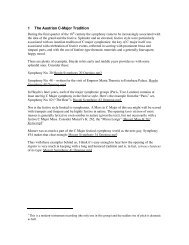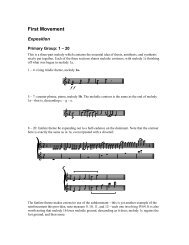Mozart Symphony No. 39 (PDF) - Scott Foglesong
Mozart Symphony No. 39 (PDF) - Scott Foglesong
Mozart Symphony No. 39 (PDF) - Scott Foglesong
Create successful ePaper yourself
Turn your PDF publications into a flip-book with our unique Google optimized e-Paper software.
I bring this up because of a silly writer of the name of Fétis who was active during the early 19 th<br />
century, up to about 1850-ish or so. He wrote the following review of a performance of the E-flat<br />
symphony in his Revue Musicale, on April 27, 1828:<br />
The E-flat <strong>Symphony</strong> has not the brilliance we expect after the grand effects of Beethoven’s symphonies.<br />
There are no parts for the oboes, because at the time <strong>Mozart</strong> wrote it oboists played in that key only with<br />
considerable difficulty, regarding it as too arduous.<br />
Well, let’s see if the oboe wasn’t used in other symphonies in E-flat of the era. There are three<br />
other <strong>Mozart</strong> symphonies in E-flat major: K. 16 (listed as #1, but probably the work of Leopold<br />
rather than Wolfgang), K. 132, and K.184. They all have a pair of oboes. K. 543 is the only one<br />
of <strong>Mozart</strong>’s without.<br />
Haydn’s symphonies in E-flat major are: 11, 22, 36, 43 (Mercury), 55, 74, 76, 84, 91, 99, and<br />
103. Every single one of them uses oboes—well, #22 uses English horns (same difference.)<br />
So, of the symphonies of major composers of the late 18 th century, the only one that doesn’t use<br />
oboes is K. 543, the topic at hand.<br />
Monsieur Fétis was once again filled with merde. (Practically every bit of Fétis I’ve come across<br />
has been as blatantly inaccurate as the above quote.) One could perhaps rationalize that Fétis<br />
didn’t know those early symphonies of <strong>Mozart</strong>. But apparently he didn’t know any of the Paris or<br />
London symphonies of Haydn, either. #103, the “Drumroll”, was still fairly popular in the 1820s.<br />
And yet this guy was to become a professor of theory at the Conservatoire. (He wasn’t one yet in<br />
1828.)<br />
Incidentally, Fétis did write some major works on counterpoint and a good (for the time) history<br />
of music that he never completed. He taught counterpoint at the Conservatoire and later on<br />
wound up heading the Brussels Conservatoire. However, his other voluminous writings are<br />
marked by inaccuracies, bad judgement, and often a biased and downright unfair attitude towards<br />
other composers and teachers. I note with some amusement that an equally silly writer, Georges<br />
de Saint-Foix, in his “The Symphonies of <strong>Mozart</strong>” (written originally in 1947) quotes Fétis as an<br />
explanation for the lack of oboes in <strong>Symphony</strong> <strong>No</strong>. <strong>39</strong>. (French musicology has always tended to<br />
run towards overstatement and inaccuracy, combined with an almost trained-seal habit of<br />
swallowing other French musicologists’s opinions whole.)<br />
2.3 Textures<br />
<strong>Mozart</strong> is much more inclined to write complex orchestral textures than other composers of the<br />
era. The average orchestral texture is two-part, with melody and accompaniment. Three-part<br />
textures aren’t quite as common; more than three blocks of sound (two melodies with<br />
accompaniment—which includes bass and harmony) tend to become too difficult to follow.<br />
Second Movement: Measures 77 – 83 provide a very nice demonstration of a fairly complex<br />
orchestral texture. Violin1 carries the main melody; basses and violin 2 carry a counter melody,<br />
while the wind choir carries yet a third melody. The accompaniment consists of an E-flat pedal<br />
point. II - 77 - 83.mp3 It’s a three-part texture that almost becomes a four-part.<br />
2.4 Treatment of Winds<br />
2.4.1 The Emergence of the Clarinet<br />
The clarinet comes into the orchestra during the Viennese Classical period, and <strong>Mozart</strong>—ever on<br />
top of the latest advances—is one of the first composers to use it with regularity.





